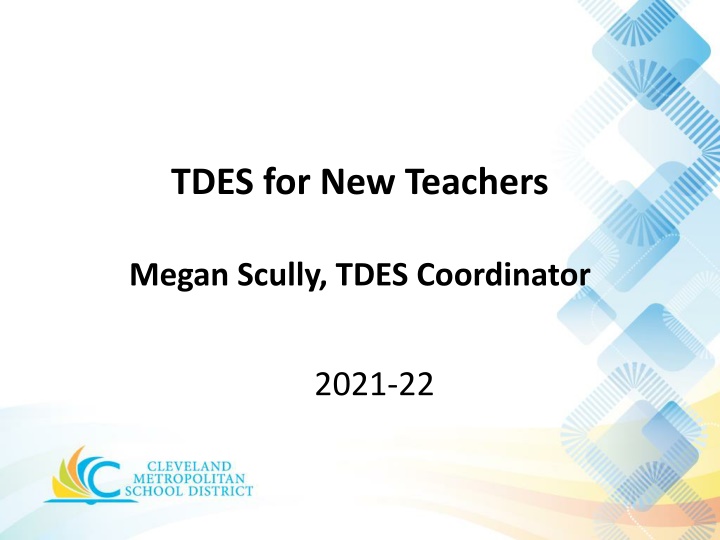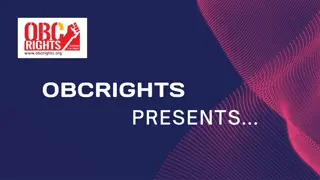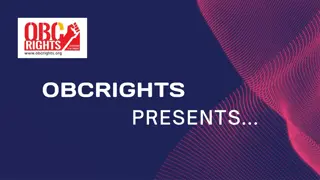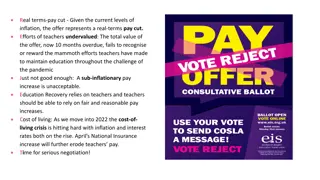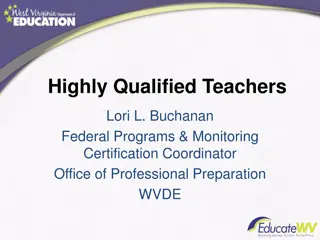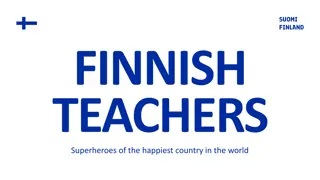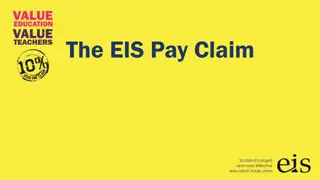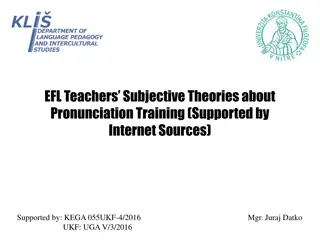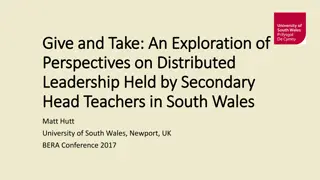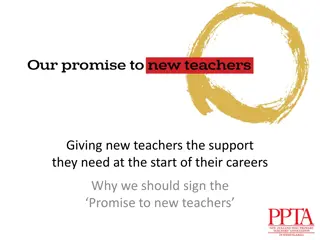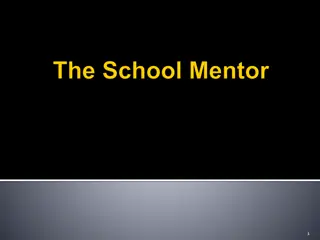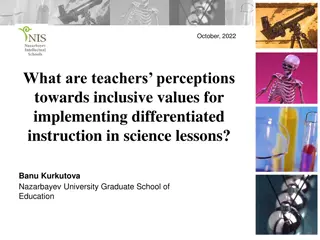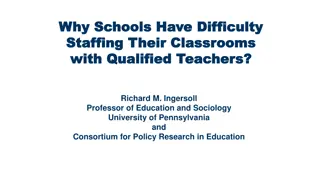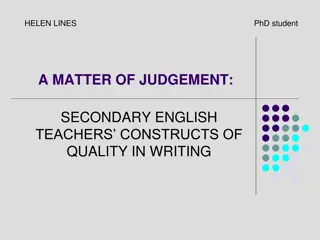TDES for New Teachers
In this session led by Megan Scully, TDES Coordinator, new teachers will delve into the Teacher Development and Evaluation System (TDES), exploring the process, rubric elements, and evidence collection techniques. The agenda covers introductions, TDES overview, rubric analysis, and discussion on authentic evidence. Participants will gain insights into teaching quality levels and their educator responsibilities. The session also touches on research by Charlotte Danielson and laws such as HB 153, HB 525, and SB 216 affecting teacher evaluation in Ohio. Stay updated with TDES developments for the year 2019-2020.
Download Presentation

Please find below an Image/Link to download the presentation.
The content on the website is provided AS IS for your information and personal use only. It may not be sold, licensed, or shared on other websites without obtaining consent from the author.If you encounter any issues during the download, it is possible that the publisher has removed the file from their server.
You are allowed to download the files provided on this website for personal or commercial use, subject to the condition that they are used lawfully. All files are the property of their respective owners.
The content on the website is provided AS IS for your information and personal use only. It may not be sold, licensed, or shared on other websites without obtaining consent from the author.
E N D
Presentation Transcript
TDES for New Teachers Megan Scully, TDES Coordinator 2021-22
Welcome! We will get started soon! 2
Thought Question Think about a lesson you felt was highly effective.. What were the elements that led you to this decision? *Please be ready to share your ideas
Introductions Megan Scully, TDES Coordinator megan.scully@clevelandmetroschools.org (216) 838-0061
Agenda Introductions What is TDES? The TDES Process Dive Deep into the Rubric (high-quality data) Authentic Evidence Questions
Norms for our Virtual Session D Embrace & provide feedback Professional pride Assume the best Low tech, high engagement Mute Non-public chat
Objectives Know the process: Participants will understand the TDES process and their responsibilities as an educator. Know the rubric: Participants will begin to build their understanding of the TDES rubric, including key elements that define teaching quality at different levels of performance. Collect Evidence: Participants will strengthen their ability to create and collect authentic evidence to showcase their teaching.
What is TDES? Teacher Development and Evaluation System 4/12/2025 9
What is the research? Enhancing Professional Practice: A Framework for Teaching, 2nd edition, by Charlotte Danielson. 4/12/2025 10
What is the law? HB 153 Establishes a new teacher evaluation system in Ohio HB 525 Legislates the Cleveland Plan for reform SB 216 Adding High-Quality Student Data to rubric 4/12/2025 11
Updates to TDES 2019-2020 100% Requires evaluation based 100% on professional practice rubric Eliminates student growth component Rubric describes high-quality teaching practice Evidence of student learning using high-quality data required 12
How is TDES different? More opportunities for observation. Evidence-based evaluation. Opportunities for conversation and reflection. 4/12/2025 13
Who evaluates me? Teachers: building administrators (Principal, Assistant Principal, or CIS) Paras: building administrators Other staff: supervisors or principals Evaluator will be the same for all steps (unless a leave occurs) 4/12/2025 14
When will I be evaluated? TDES Process (Traditional/Extended) Growth Plan (September 24) Walkthrough 1 (Ineffective only) (October 22 ) Formal Announced Observation (December 17) Unannounced Observation (February 25) Walkthrough (April 14) Final Composite (Portal Closes May 6) 4/12/2025 4/12/2025 15 15
What is the Portal? The TDES is managed online. The Great Teachers & Great Leaders website is called the portal. User name/password are the district log in. 4/12/2025 16
Overview of TDES Process 2019-2020 (Accomplished and Skilled) Events One formal announced observation One unannounced observation One walk-through Evaluation Frequency Accomplished: evaluated every 3 years Skilled: evaluated every other year Off Year Growth plan check-in Conference Professional Growth Plans Accomplished professionals will write a self-directed growth plan Skilled professionals will write a jointly developed growth plan with their evaluator or principal 17
Overview of TDES Process 2019-2020 (Developing and Ineffective) Events One formal announced observation One unannounced observation One walk-through Ineffective: Additional walk-through Evaluation Frequency Every year Improvement and Growth Plans Developing: Professional Growth Plan Ineffective: Professional Improvement Plan 18
What is the Process? Growth or Improvement Plan Formal Announced Observation Walk-through (Ineffective Only) Unannounced Observation Composite Walk-through
PGP Dates PGP/IP Due: September 24 (all schools/RSPs) PGP Check in: Quarter 2 or 3 (October 25 - March 18) PGP Conference: Quarter 2 or 3 (see dates above)
Growth Plans and Improvement Plans Professional Growth Plans Professional Improvement Plans Two goals: one goal based on a TDES component and one goal based on an element from the standards Evaluator will work with the professional to set at least two no more than three goals based on a TDES component and one element from the standards. Review the previous year s progress when determining goals and plan to achieve goals. Guide professional s work for the year Guide professional s work for the year Discussed at post-conferences Discussed at post-conferences Assessed at the end of the year Assessed at the end of the year Review value-added data, if applicable Review value-added data, if applicable 21
Overview of Growth Plan Check-In Professional and evaluator schedule the check-in. Evaluator visits classroom for at least 30 minutes to observe practice. Evaluator focuses on providing feedback on the goals identified in the growth plan. Evaluator notes in the portal the professional s progress. 22
Growth Plans During Off Years Accomplished Skilled Develop a self-directed professional growth plan Jointly develop a professional growth plan One check-in visit One check-in visit Conference Conference 23
TDES Mailbox TDES@clevelandmetroschools.org *send an email when the event is not completed by the due date
Formal Announced Observation (1 of 2) 1. Evaluator and professional collaboratively schedule the FAO and pre-and post-conferences 2. Teacher submits lesson plan through the portal 3. Teacher and evaluator hold a pre-conference to discuss the lesson plan 4. Evaluator observes lesson for at least 30 minutes 5. Evaluator submits evidence; teacher can submit evidence
Formal Announced Observation (2 of 2) 6. Teacher self-assesses on the rubric 7. Evaluator marks areas of agreement on the rubric and shares with the teacher 8. Teacher and evaluator meet for the post- conference to discuss and complete rubric All must occur within 10 working days from pre- conference to post-conference.
Unannounced Observation (1 of 2) 1. Evaluator conducts classroom observation of at least 30 minutes. 2. Evaluator submits evidence in the portal; teacher can add evidence if desired. 3. Evaluator schedules post-conference in the portal.
Unannounced Observation (2 of 2) 4. Teacher-self assesses on the rubric. 5. Evaluator marks areas of agreement on the rubric. 6. Teacher and evaluator meet for a post- conference to discuss ratings and complete rubric. All must occur within 10 working days from observation to post-conference.
Walk-through Informal 5-15 minute observation of practice Evaluator records evidence of the teacher s practice Teacher receives notice that evidence is submitted in the portal Teacher has the option to add evidence to the portal Post-conference is optional
Composite Final step to arrive at overall observation rating 1. Evaluator schedules steps in the portal. 2. Teacher self-assesses on Composite rubric. 3. Evaluator marks areas of agreement 4. Evaluator and teacher meet for Composite conference to discuss. 5. Evaluator determines final Composite rating. 6. Must be completed by May 6 when portal closes.
Defining Excellent Instruction TDES Teacher Rubric Domain 1: Planning & Preparation 1a: Demonstrating knowledge of content and pedagogy 1b: Demonstrating knowledge of students 1c: Setting instructional outcomes* 1d: Demonstrating knowledge of resources 1e: Designing coherent instruction* 1f: Designing student assessment Domain 2: Classroom Environment 2a: Creating an environment of respect and rapport 2b: Establishing a culture for learning that is challenging and rigorous* 2c: Managing classroom procedures* 2d: Managing student behavior* 2e: Organizing physical space Domain 3: Instruction 3a: Communicating with students 3b: Using questioning and discussion techniques 3c: Engaging students in learning* 3d: Using assessment in instruction* 3e: Demonstrating flexibility and responsiveness Domain 4: Professional Responsibilities 4a: Reflecting on teaching 4b: Maintaining accurate records* 4c: Communicating with families 4d: Participating in a professional community 4e: Growing and developing professionally 4f: Showing professionalism*
Power Components TDES Teacher Rubric Domain 1: Planning & Preparation 1a: Demonstrating knowledge of content and pedagogy 1b: Demonstrating knowledge of students 1c: Setting instructional outcomes* 1d: Demonstrating knowledge of resources 1e: Designing coherent instruction* 1f: Designing student assessment Domain 2: Classroom Environment 2a: Creating an environment of respect and rapport 2b: Establishing a culture for learning that is challenging and rigorous* 2c: Managing classroom procedures* 2d: Managing student behavior* 2e: Organizing physical space Domain 3: Instruction 3a: Communicating with students 3b: Using questioning and discussion techniques 3c: Engaging students in learning* 3d: Using assessment in instruction* 3e: Demonstrating flexibility and responsiveness Domain 4: Professional Responsibilities 4a: Reflecting on teaching 4b: Maintaining accurate records* 4c: Communicating with families 4d: Participating in a professional community 4e: Growing and developing professionally 4f: Showing professionalism*
What are the Power Components? 1c: Setting instructional outcomes 1e: Designing coherent instruction 2b: Establishing a culture for learning that is challenging and rigorous 2c: Managing classroom procedures 2d: Managing student behavior 3c: Engaging students in learning 3d: Using assessment in instruction 4b: Maintaining accurate records 4f: Showing professionalism
TDES Rubric Domain 1: Planning and Preparation Domain 2: The Classroom Environment Danielson Framework for Teaching Domain 3: Instruction Domain 4: Professional Responsibilities 35
High Quality Data Activity Choose: Table leader Timekeeper Recorder 36
Reflect and Discuss Table leaders and timekeepers will give you 3 minutes to jot down your thoughts. In 5 minutes, discuss and summarize your ideas to share out. How do educators and students benefit from the use of high-quality student data? 37
HOW are high-quality student data used for instruction? Spend 5 minutes individually brainstorming ways teachers use these data sources for instruction Share ideas one at a time Be ready to share. 38
HQSD Evidence Tenants of high-quality assessments: Measure what they are intended to measure Align to grade-level and content subject standards Provide data that can be used to inform instruction Are accessible to the majority of students Provide timely results Accurately and fairly measure student growth or progress over time Source: TDES Guidebook 2019-2020, page 10
High-Quality Student Data Teachers may use sources of high-quality student data from a menu of high-quality assessments that: Measure what they are intended to measure Align to grade-level and content standards Provide data that can be used to inform instruction Are accessible to the majority of students Provide timely results Accurately and fairly measure student growth or progress over time 40
Example Sources of Evidence 1b: Demonstrating knowledge of students 1c: Setting instructional outcomes Reviewing a student s IEP. A conference discussion where the teacher reflects on their knowledge of students and how she/he obtained this information. Lesson plan outlines goals aligned to curriculum standards and based on an analysis of student data. A conference discussion on how goals were determined based on data. 1f: Designing student assessment 3d: Using assessment in instruction Observes administration of formative or summative assessment such as quizzes, projects, benchmarks. Observes feedback provided to students such as after students present from a performance-based assessment. A lesson plan describes assessments from multiple formative and summative sources. A teacher shares the plans for future instruction based on student data during a conference conversation. 41
How does the rubric language encourage the use of high-quality student data to leverage improvements in instructional practice? Be ready to share 42
Component Skilled Description Sample Sources of Evidence 1b: Demonstrating knowledge of students Teacher actively seeks knowledge of students backgrounds, cultures, skills, language proficiency, interests, and special needs, and attains this knowledge for groups of students. Teacher draws upon an accurate analysis on multiple sources of high-quality student data for groups of students. Survey data to get to know student s family and background Analysis of previous year OST /EOC data Analyzing students strengths/weakness from benchmark assessments such as NWEA Examining students language proficiency from OELPA data and/or student artifacts Reviewing a student s IEP A conference discussion where the teach reflects on their knowledge of students & how she/he obtained this information Source: TDES Guidebook, 2019
Component Skilled Description Sample Sources of Evidence 1c: Setting instructional outcomes Instructional outcomes are stated as goals reflecting high-level learning and curriculum standards that align with the Ohio standards, using multiple sources of high-quality student learning data. Outcomes are suitable for most students in the class, represent different types of learning and are capable of assessment. The outcomes reflect opportunities for coordination Lesson plan outlines goals aligned to curriculum/standards and based on analysis of student data A conference discussion on how goals were determined & based on what data Source: TDES Guidebook, 2019
Component Skilled Description Sample Sources of Evidence 1f: Designing student assessment Lesson plan describes plan for assessment and includes multiple sources from formative/summative assessments A conference discussion where the teacher shares his or her plan for assessment and how to adapt assessment methodology for individual students A conference discussion where the teacher shares his or her plan for future instruction based on student data Teacher s plan for student assessment is aligned with the instructional outcomes, using clear criteria, is appropriate to the needs of students. Teacher intends to use multiple sources of high- quality student data to plan for future instruction for groups of students. Source: TDES Guidebook, 2019
Component Skilled Description Sample Sources of Evidence 3d: Using assessment in instruction The teacher uses aligned formative or summative (formal or informal) assessment(s) to check for understanding for subgroups of students. There is monitoring of progress of learning by teacher and/or student. Consistent, actionable, high-quality feedback is given to students. Observes administration of formative or summative assessment such as quizzes, projects, benchmark assessments Observes feedback provided to students such as after students present from a performance-based assessment Observes teacher or peer feedback provided to students Source: TDES Guidebook, 2019
Report Out! 47
2c: Managing Classroom Procedures What does it look and sound like in a classroom with strong routines and procedures?
2c: Managing Classroom Procedures Ineffective Developing Skilled Accomplished Much instructional time is lost due to inefficient classroom routines and procedures, for transitions, handling of supplies, and performance of non-instructional duties. Some instructional time is lost due to only partially effective classroom routines and procedures, for transitions, handling of supplies, and performance of non-instructional duties. Little instructional time is lost due to classroom routines and procedures, for transitions, handling of supplies, and performance of non-instructional duties, which occur smoothly. Students contribute to the seamless operation of classroom routines and procedures, for transitions, handling of supplies, and performance of non-instructional duties.
2d: Managing Student Behavior What does it look and sound like in a classroom with excellent management of student behavior?
